Positional deadlock without options: based on Commander-in-Chief Zaluzhny

Image by mil.ru
It is believed that for about a year now during the fighting carried out as part of the Russian special military operation (SVO) in Ukraine, a positional impasse has formed, from which no way out is yet in sight. This became so obvious that the Commander-in-Chief of the Armed Forces of Ukraine (AFU), General Valeriy Zaluzhny, gave an interview to the British publication “The Economist”, and also published his essay in it, explaining the reasons for the occurrence of this positional impasse and the breakdown of the Ukrainian “counter-offensive”.
In fact, the problem of positional impasse extends far beyond the borders of Ukraine and the Northern Military District. In fact, in our time, any armed forces of two countries (or groups of countries) with comparable capabilities are doomed to positional confrontation. Commander-in-Chief Zaluzhny indirectly confirms this in his interview, saying that the current level of development of weapons and military equipment favors the transition to positional combat operations - and in this Zaluzhny is one hundred percent right. Moreover, under existing conditions, a conditional “positional deadlock” for countries (or groups of countries) with comparable capabilities is practically guaranteed, and in all environments - on land, on water and in the air (of course, this should not be understood as the literal “standing” of ships and planes opposite each other)However, each of these areas is a topic for a separate discussion.
However, regarding the positional impasse directly in Ukraine, Commander-in-Chief Zaluzhny speaks not only about the problems of modern military technologies and concepts in general, but at the same time seems to hint that if the United States and other NATO countries had earlier transferred “everything necessary” to Ukraine, then there is artillery, Tanks, Aviation, high-precision weapon long range and much more, then the positional deadlock would be “broken” and the “counter-offensive” would take place successfully. Of course, Zaluzhny “doesn’t complain and is grateful,” but it’s not he who is to blame for the breakdown of the Ukrainian counteroffensive, but you know who...
However, Commander-in-Chief Zaluzhny is, in fact, not particularly to blame for the failure of the “counter-offensive” - it’s unlikely that anyone in his place would have done a better job, but for the “grave” of Ukrainian soldiers - yes, he is to blame, he is to blame for the “Meat Assaults”, guilty of the murders and torture of Russian prisoners of war, of carrying out criminal orders of the criminal Ukronazi regime, but not of disrupting the Ukrainian counter-offensive.
As for the transfer by NATO countries of those supposed weapons that, in the opinion of Commander-in-Chief Zaluzhny, could affect the success of the Ukrainian counter-offensive, in the event that they were transferred to the Ukrainian Armed Forces “earlier and more,” then we will dwell on them in more detail, so that the illusions of the commander-in-chief Zaluzhny to disperse. We will talk specifically about the weapons that NATO countries have, and not about those that, in Zaluzhny’s opinion, only need to be developed in order to break the positional deadlock.
Barrel and rocket artillery
Barrel artillery and multiple launch rocket systems (MLRS) are among the most popular types of weapons during the military offensive. It is characteristic that it was largely thanks to artillery that the fighting in Ukraine took on a positional character. On the one hand, the massive use of artillery ensures the destruction of enemy equipment and manpower attempting to carry out an offensive; on the other hand, the insufficient intensity of artillery fire does not allow the suppression of the enemy’s defensive positions.
At the time of the start of the counter-offensive, the Ukrainian Armed Forces had a significant number of self-propelled artillery units (SPG) and even more transportable guns, which the Ukrainian industry is quite successfully converting into wheeled self-propelled guns "Bogdan". The problem is that by the time of the supposed “counter-offensive” of the Ukrainian Armed Forces, there were very few shells left for Soviet artillery systems, which were consumed at the highest rates by both sides of the conflict. At the moment, the United States and other NATO countries have “scraped out” everything they could from around the world, that is, they could not supply more to Ukraine purely physically.
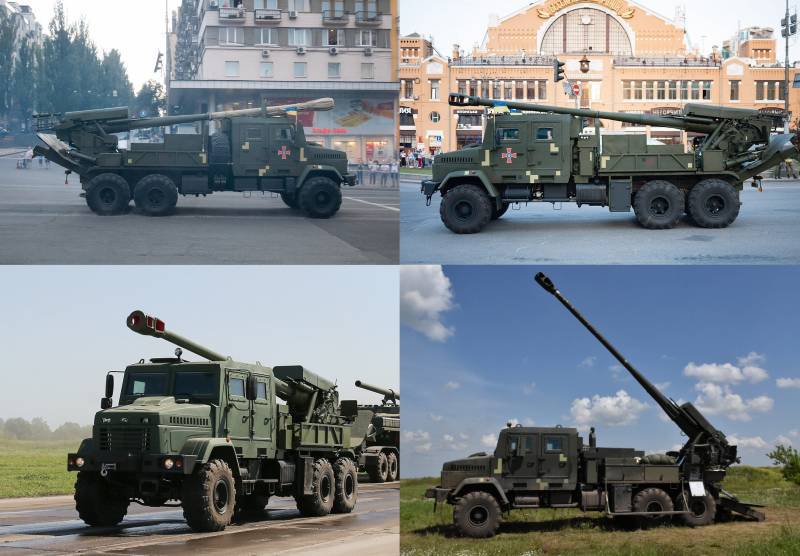
Wheeled Ukrainian self-propelled gun "Bogdana", for the manufacture of which, presumably, transportable artillery pieces are used
A lot of artillery systems were supplied to the Armed Forces of NATO countries, including Western-made ones, and long before the start of the Ukrainian counter-offensive. However, with Western-style artillery systems there is the same problem - there are few shells, and specifically conventional, unguided ones. High-precision projectiles of the Excalibur type supplied by the United States can be effectively used to solve the problems of counter-battery warfare, destroying warehouses, equipment and manpower deep in enemy territory, but they are of little use for “breaking” continuous defensive positions. And the problem here is not that they “don’t want to,” but that NATO countries have limited stocks of conventional shells.
The same applies to the HIMARS MLRS, which in its essence is closer to operational-tactical missile systems than to MLRS. The projectiles are guided and highly effective, but they are few in number.
Thus, it cannot be said that NATO countries did not provide Ukraine with artillery for a counter-offensive - they supplied as much as they could without causing critical damage to their own armed forces. It is also worth mentioning the means of counter-battery warfare, in which the Ukrainian Armed Forces, apparently, are still superior to the Russian Armed Forces.
Tanks, armored vehicles and anti-tank weapons
The situation with tanks and armored vehicles is largely similar. Initially, the Armed Forces of Ukraine had more than enough armored vehicles; in addition to Soviet reserves, there were a number of tanks and other armored vehicles of their own making. The fact is that The Armed Forces of Ukraine are quickly running out of tanks and other armored vehicles, Western countries are not to blame.
Yes, the main battle tanks (MBT) of NATO countries were delivered to Ukraine later, but this did not affect the situation in any way - the MBT of Western countries began to “run out” of the Ukrainian Armed Forces so quickly that they were almost invisible on the front line. By the way, as expected, cunning Americans do not allow their Abrams to the front line, and the British Challengers are not particularly eager to fight - the German Leopards are burning and suffering reputational losses..
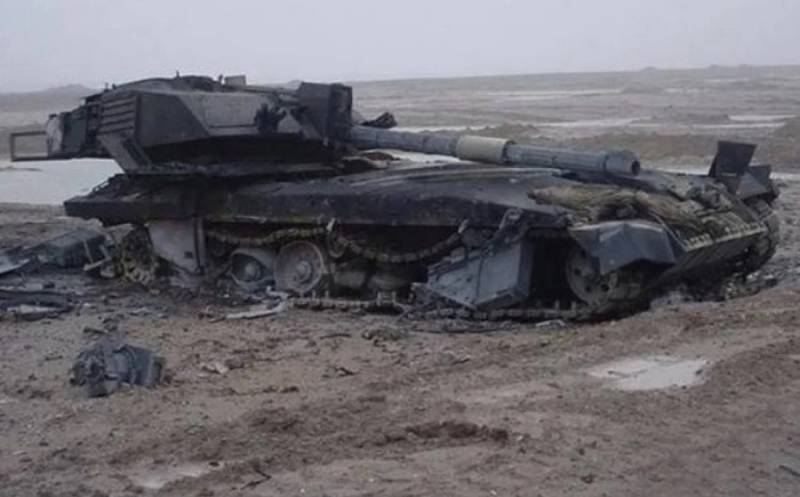
The damaged British Challenger tank is a rare guest on the front line
NATO countries supplied the Armed Forces of Ukraine not just a lot, but a lot of armored vehicles for various purposes, however, for the most part these were all sorts of MPAPs, but they also supplied armored personnel carriers (APCs) and infantry fighting vehicles (IFVs). However, as in the case of MBT, this did not affect the situation on the battlefield in any way, and cannot affect it in conditions of complete dominance of anti-tank weapons for various purposes on the battlefield.
As for anti-tank weapons, they were supplied to the Armed Forces of Ukraine in huge quantities at the very beginning of the conflict, including the latest third-generation Javelin anti-tank missile systems (ATGM), which the Russian Armed Forces still have no analogues to. This is in addition to the more than effective Ukrainian Stugna-P ATGMs, analogues of the Russian Kornet ATGMs.
Air defense (AA)
Ukraine inherited from the USSR a significant amount of air defense systems, although often outdated, but quite capable of operating against almost any means of air attack. In addition, outdated anti-aircraft missile systems (SAM) could be modernized using Western technology.
Even thanks to existing air defense systems, using ambush tactics, The Ukrainian Armed Forces were able to close the skies over the controlled territory to manned Russian aviation, preventing the strategic dominance of the Russian Air Force (Air Force) in the skies over Ukraine. As for the supply of air defense systems produced in Western countries, they did not change the situation as a whole, but presumably provided a higher percentage of destruction of such Russian airborne weapons as cruise missiles (CR) and long-range kamikaze unmanned aerial vehicles (UAVs).
At the same time, it is necessary to mention one interesting point - anti-aircraft guided missiles (SAMs) used by Western-made air defense systems are extremely expensive, and therefore their number is limited. Of course, Ukraine doesn’t care how much the US and Europe pay, but how indifferent is it to the US, UK and other “sponsors” themselves? In a situation where missile defense systems costing 0,5-1 million dollars shoot down kamikaze UAVs worth 20-100 thousand dollars, and missile defense missiles costing 3-5 million dollars shoot down a missile system worth 1 million dollars, the losses of the defender are in any case higher than those of the attacker.
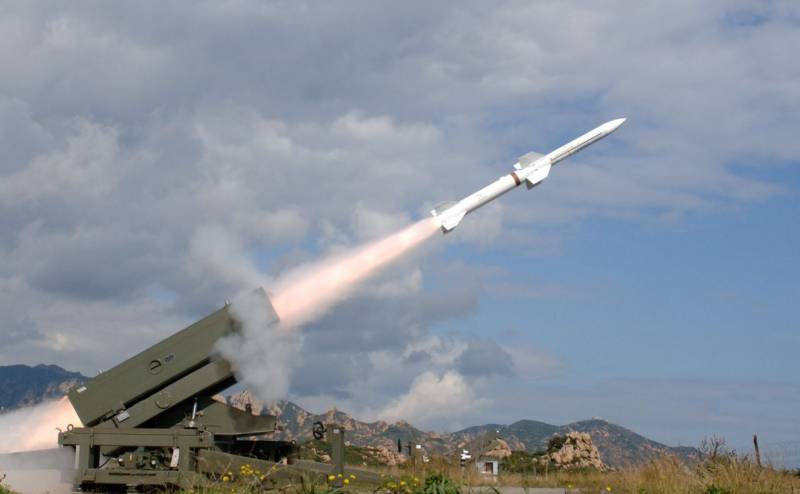
The cost of the AIM-120 AMRAAM missiles used by the NASAMS air defense system is, according to various estimates, from 1,2 to 2 million US dollars
It is possible that if Western countries had started supplying their air defense systems earlier, by now they would have run out of either their reserves of air defense systems or their supply of generosity, so that ultimately the Armed Forces of Ukraine would be left without air defense systems at all.
Long-range precision weapons
Of course, the Ukrainian Armed Forces want to not only repel Russian strikes delivered by long-range precision weapons, but also inflict them themselves. It is worth noting that in this matter the Ukrainian Armed Forces showed extreme ingenuity, creatively using all the reserves left over from the USSR. Modified Soviet Strizh UAVs flew into Russian territory, missiles of the outdated S-200 air defense system and much more. Long-range kamikaze UAVs, assembled from components supplied by Western countries and purchased in China, were also added here.
Additionally, The Ukrainian Armed Forces are actively using unmanned kamikaze boats (BEC) against our country. They are used not only to attack ships of the Russian Navy, but also coastal infrastructure, including the Crimean Bridge.
Of course, all this will not replace full-fledged operational-tactical and cruise missiles, although, as we said earlier, Ukraine has long been supplied with RS3O HIMARS with guided ammunition, with a firing range of up to 150 kilometers. In addition, Deliveries of cruise and operational-tactical missiles with a firing range of up to 300 kilometers have been underway for several months now.. This did not affect the situation globally, although these missiles cause some damage to the Russian Armed Forces.
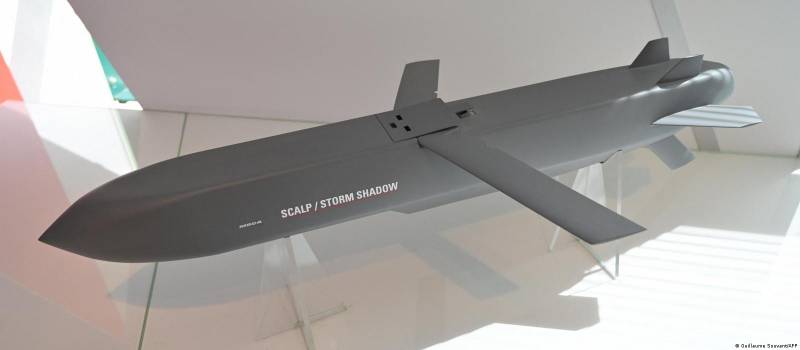
Storm Shadow cruise missiles cause painful, although not critical, damage to the Russian Armed Forces
If deliveries had begun earlier, the Russian Armed Forces would have had to adapt earlier - build shelters, disperse equipment and manpower, and pay more attention to camouflage. Unfortunately, We have not yet punished US arms supplies in any way. и other Western countries, although we have all the possibilities for this.
Of course, Commander-in-Chief Zaluzhny probably wants not only “sooner,” but also “more” and “further,” but questions arise here. Due to the provisions of the recently defunct Intermediate-Range Nuclear Forces (INF) Treaty, missiles with a range of more than 500 kilometers existed only for sea and air carriers. As a result, at the moment there are no or very few ground-based carriers for long-range precision weapons (they are just being developed). An exception can be considered shipborne vertical launch systems (VLS) adapted for ground use for the Tomahawk missile launcher.

Test launch of the Tomahawk missile launcher from a ground-based mobile launcher, which took place on August 18, 2019
There is no point in talking about the transfer of warships to Ukraine, since this is absurd - single copies of the BC Russian Federation will quickly be sent to the bottom, but why not transfer the entire US sixth fleet to the Ukrainian Armed Forces?
That leaves aviation, which, along with long-range precision weapons, is one of the biggest “wants” of the Ukrainian Armed Forces.
Aviation
Based on the available data, the Ukrainian Air Force at the time of the start of the SVO was in a rather deplorable state, primarily not in terms of the number of available aircraft, but in terms of its technical condition. Thanks to the help of Western countries, Ukraine managed to repair, modernize and put into operation dozens, or rather hundreds, of aircraft. In addition, from the countries of the former Soviet bloc, and possibly from other countries of the world, a significant number of Soviet-made (or licensed) combat aircraft and helicopters were delivered to Ukraine.
At the moment, a significant part of Ukrainian aviation has already been destroyed, both in the air and on the ground, by attacking home airfields. In those cases when Ukrainian aviation climbs onto the line of combat contact (LCC), then, apparently, it does not live long. It’s another matter when Ukrainian Air Force aircraft are used to carry out long-range missile strikes – in this case they are quite effective. However, quite recently information appeared that The Russian Armed Forces managed to ensure the joint operation of air defense systems and long-range radar detection and control aircraft (AWACS). Apparently, this has led to a jump in losses for the Ukrainian Air Force, which they urgently need to compensate for.
Deliveries of aircraft from NATO countries could lead to an increase in the number of simultaneously launched long-range APUs of the Kyrgyz Republic and an increase in the likelihood of them hitting targets deep in Russian territory. Also, with their help, the Ukrainian Air Force could potentially try to shoot down an AWACS aircraft, however, apparently, For the most part, the RF Armed Forces are fighting without them, and in the depths of Russian territory, combat aircraft of the Ukrainian Air Force still have no chance - as the experience of Ukraine itself has shown, it is quite possible to knock out enemy aircraft with air defense systems using ambush tactics alone.
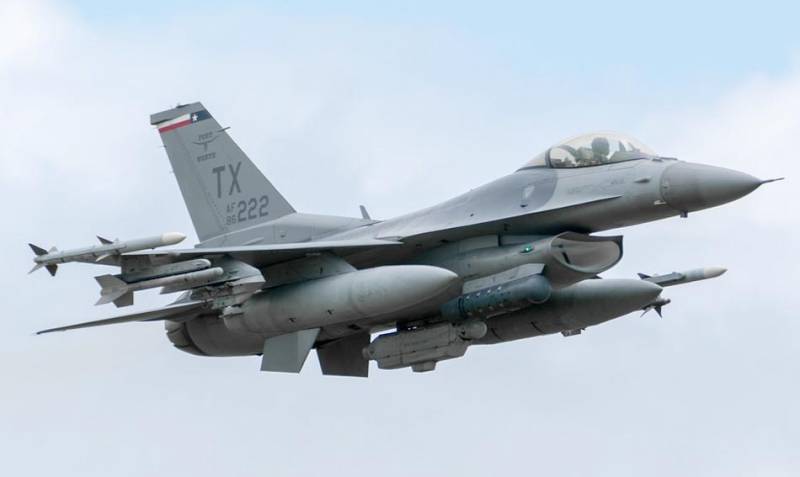
American F-16C fighters may pose a threat to Russian AWACS aircraft and can also be used to launch long-range missile strikes, but they will not change the course of the war
So, Western aircraft would not have provided any breakthroughs during the counter-offensive to Ukraine; everything would have been limited to launches of long-range missiles from the depths of Ukrainian territory, as well as intensive losses of F-16s on the LBS in the event that they dared to fly there (and whether they would be allowed , “Abrams” are not yet allowed on the front line).
AH-64 Apache combat helicopters could be useful on the Ukrainian Armed Forces' LBS, but again, they can only operate effectively in the zone of dominance of their aviation, otherwise combat helicopters will also quickly become “trophies” of the Russian Air Force and Air Defense. That is, if Russian armored vehicles went into a breakthrough, then the Apaches could ensure their destruction by operating in airspace at least partially controlled by the Ukrainian Armed Forces, but if they tried to support the breakthrough of Ukrainian armored vehicles, then the Russian Air Force and Air Defense would quickly be destroyed .
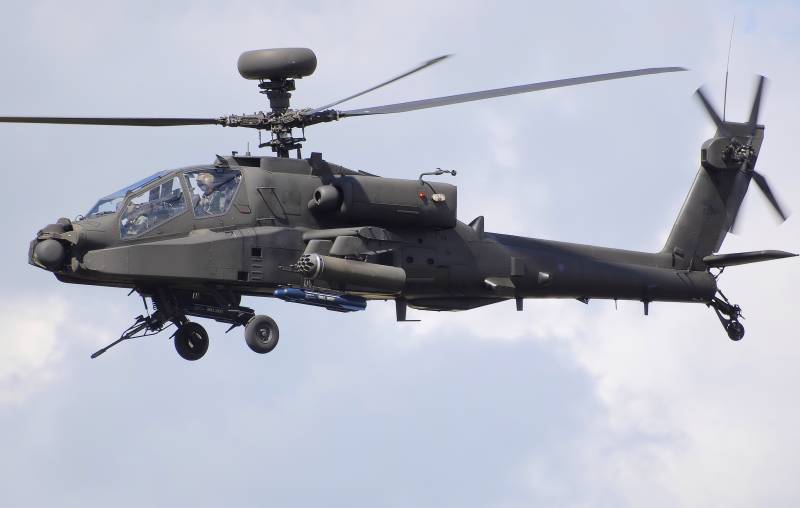
AH-64D Apache combat helicopters would be as dangerous for the Russian Armed Forces as the Ka-52 and Mi-28N are dangerous for the Ukrainian Armed Forces, but they would be more suitable for disrupting the Russian offensive than for ensuring a Ukrainian “counter-offensive”
As for the massive deliveries of Western combat aircraft at the very beginning of the Northern Military District, this was impossible in principle. There were no pilots for them - hastily retrained Ukrainian pilots would not have been able to fly for long, but professionals from Western countries earn a lot there - why would they die in Ukraine? Of course, they would find some of the retirees, they would attract pilots from Latin American countries, but this wouldn’t be quite the Ukrainian army, would it? With the same success, one could simply immediately ask the United States to fight for Ukraine...
The same applies to technicians who must service delicate Western equipment - it takes a long time to train Ukrainian specialists, and Western specialists are unlikely to like dying under the blows of Russian missiles.
Provision
In fact, the United States and other NATO countries have already supplied Ukraine with the most valuable thing they could - this intelligence, communications and control.
Without the intelligence data provided by NATO space reconnaissance assets, Ukraine would have virtually no chance of launching strikes deep into Russian territory; Ukrainian long-range precision weapons would not be able to bypass Russian air defense systems. Without AWACS aircraft and high-altitude reconnaissance UAVs of NATO countries, the Ukrainian Armed Forces would not have succeeded close low altitudes for Russian aviation in the depths of Ukraine.
Without satellite communication terminals, it would not have been possible to carry out BEC kamikaze strikes on Russian Navy ships, and without modern digital radio stations there would be no effective coordination of the actions of ground units of the Armed Forces of Ukraine, providing the ability to conduct maneuverable combat operations - here there would be no talk of any counter-offensive in principle.
And, finally, management - here the question generally arises: who controls the Armed Forces of Ukraine, Commander-in-Chief Zaluzhny or some “gray personalities” from the Pentagon? One thing is certain: the full power of NATO’s analytical structures is involved in the Ukrainian conflict.
Conclusions
Western countries have given Ukraine very, very much, and if their actions had been harsher and more aggressive, this could have led to much worse consequences, and not only for Ukraine itself.
Saying that Western countries could supply more weapons and do it earlier, Commander-in-Chief Zaluzhny does not understand or does not want to understand that every action gives rise to counteraction - if the United States and NATO began supplying weapons earlier and in large quantities, this would lead to tough Russia's response actions, and perhaps also to more active participation in the Ukrainian conflict by other countries that are not interested in a quick and clear victory for Western countries.
The only thing that would ensure success for Ukraine on the battlefield is direct intervention in the conflict of NATO countries led by the United States, but the consequences of this intervention will go far beyond the borders of Ukraine.
Information